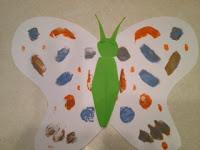Have some fun with symmetry in nature ... It's perfect for Spring!
First, find some beautiful non-fiction books that show full-winged pictures of a variety of butterflies and bugs. Have your children inspect some close-up pictures to "discover" all on their own ... lessons stick better that way! Direct their attention to specifics in the photos and have them do the "noticing."
There are also many children's book authors who use beautiful artwork displaying symmetry in fiction stories depicting animals or insects. The books might tell about the seasons, life cycles, or natural occurances such as camouflage - you might have some on hand that are already favorites of your children. Eric Carle's book, "The Grouchy Ladybug," shows symmetry in the collage work he does, even though it has other themes. Use resources you have on hand to draw attention to something new!
Then, get out there and explore! Make sure you have a "kit" to inspire your little ones to get into the activity. Our kit consisted of some plastic tweezers, magnifying glasses of different sizes, some index cards (for lifting delicate specimens), and a small container with holes to temporarily house what we found. It all fit in an old lunch box ... a small sand bucket would do nicely, too! Your child will be delighted to find all sorts of examples in the critters you uncover! Make sure they are using their words to describe what they see - and you could even bring along a sketch book and some crayons to do critter portraits :)
 For some fun artwork, when you're back from your travels, fold a large sheet of construction or other heavy paper in half. Draw the shape of a butterfly's wing (or another bug's) on one half with the center of the body at the fold. Cut through both pieces of paper so when you unfold, you have a butterfly shape. Have your child make a design on only one of the wings with some acrylic paint and then fold and press gently to transfer the design to the other wing. You should end up with a mirror image - symmetry!
For some fun artwork, when you're back from your travels, fold a large sheet of construction or other heavy paper in half. Draw the shape of a butterfly's wing (or another bug's) on one half with the center of the body at the fold. Cut through both pieces of paper so when you unfold, you have a butterfly shape. Have your child make a design on only one of the wings with some acrylic paint and then fold and press gently to transfer the design to the other wing. You should end up with a mirror image - symmetry!
You can finish up by adding a body, head and antennae with some paper scraps, pompoms, or whatever you have on hand!
Have fun!
First, find some beautiful non-fiction books that show full-winged pictures of a variety of butterflies and bugs. Have your children inspect some close-up pictures to "discover" all on their own ... lessons stick better that way! Direct their attention to specifics in the photos and have them do the "noticing."
There are also many children's book authors who use beautiful artwork displaying symmetry in fiction stories depicting animals or insects. The books might tell about the seasons, life cycles, or natural occurances such as camouflage - you might have some on hand that are already favorites of your children. Eric Carle's book, "The Grouchy Ladybug," shows symmetry in the collage work he does, even though it has other themes. Use resources you have on hand to draw attention to something new!
Then, get out there and explore! Make sure you have a "kit" to inspire your little ones to get into the activity. Our kit consisted of some plastic tweezers, magnifying glasses of different sizes, some index cards (for lifting delicate specimens), and a small container with holes to temporarily house what we found. It all fit in an old lunch box ... a small sand bucket would do nicely, too! Your child will be delighted to find all sorts of examples in the critters you uncover! Make sure they are using their words to describe what they see - and you could even bring along a sketch book and some crayons to do critter portraits :)
 For some fun artwork, when you're back from your travels, fold a large sheet of construction or other heavy paper in half. Draw the shape of a butterfly's wing (or another bug's) on one half with the center of the body at the fold. Cut through both pieces of paper so when you unfold, you have a butterfly shape. Have your child make a design on only one of the wings with some acrylic paint and then fold and press gently to transfer the design to the other wing. You should end up with a mirror image - symmetry!
For some fun artwork, when you're back from your travels, fold a large sheet of construction or other heavy paper in half. Draw the shape of a butterfly's wing (or another bug's) on one half with the center of the body at the fold. Cut through both pieces of paper so when you unfold, you have a butterfly shape. Have your child make a design on only one of the wings with some acrylic paint and then fold and press gently to transfer the design to the other wing. You should end up with a mirror image - symmetry!You can finish up by adding a body, head and antennae with some paper scraps, pompoms, or whatever you have on hand!
Have fun!



We've made similar painted butterflies. There's something SO amazing when you open the folded paper and see your paint replicated on the other wing. My sons thought it was awesome! I'd love it if you'd share this idea on the weekly After School Linky Party at my blog: deceptivelyeducational.blogspot.com
ReplyDelete